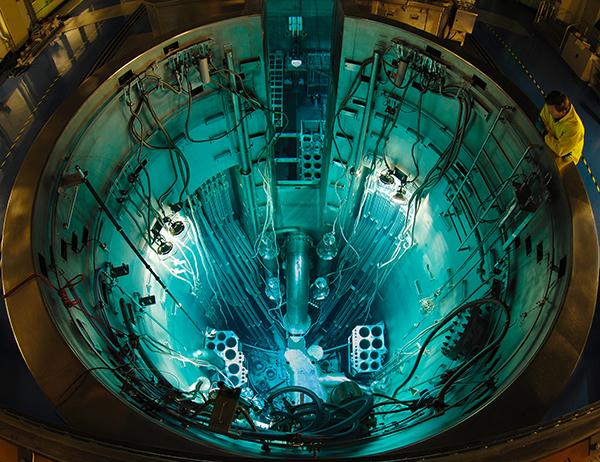Key Points
- Several innovative technologies are currently being developed by Australian clean energy technology company entX that use beta-emitting radioisotopes as an energy source.
- One of entX's novel developments is a radioisotope heater unit, which provides vital heat to spacecraft and lunar applications in the ultra-cold environment of sp ace.
- ANSTO is producing the radioisotopes in the OPAL multi-purpose reactor for entX
Australian clean energy technology company,entX Limited is taking advantage of ANSTO's unique capacity to generate tailored radioisotope products in the OPAL multi-purpose nuclear reactor to advance a series of innovative projects.
Several innovative technologies are currently being developed by entX that use beta-emitting radioisotopes as an energy source.
One of entX's novel developments is a radioisotope heater unit (RHU), which provides vital heat to spacecraft and lunar applications in the ultra-cold environment of space. For the RHU, ANSTO is helping to develop the novel radioisotope and a range of specialist expertise associated with the production and handling of the radioactive source.
The RHU platform is now being moved along the technology readiness pipeline in partnership with the iLAuNCH Trailblazer, a consortium comprising the University of Southern Queensland, The Australian National University and the University of South Australia and industry collaborators to accelerate the commercialisation of projects.
"Embarking on an exciting journey towards lunar occupation in the upcoming decades, securing a reliable source of thermal energy solutions is paramount," said entX General Manager Defence and Space, Scott Edwards.

"Robust RHUs will play a pivotal role in ensuring the safety and effectiveness of lunar surface exploration through the enigmatic lunar night. Moreover, extending asset availability during lunar nights by leveraging advanced energy technologies creates a step change in the amounts of data collected, processed, and transmitted, leading to a maximized mission ROI.
"You need a nuclear reactor to produce the radioisotopes that entX needs for its advanced platforms," explained Prof Mihail Ionescu, Leader, Nuclear Fuel Cycle research at ANSTO, who is collaborating on the project.
"And as they are custom-designed irradiations, there are many steps to work out to create the desired product, and how to handle it" he added.
"We have a lot of experience in producing and safely handling radioactive material, which is generally not something available in the industry sector".
The process of producing a radioisotope involves placing target materials to be irradiated in strictly reviewed canning designs and lowering them into optimised neutron flux locations close to the core of the reactor.
The target material captures neutrons from the fission process in the reactor, which causes the nucleus of the material to become unstable. It is this change to the particles in the nucleus that creates the new, bespoke radioisotope. To regain its stability, a radioisotope emits specific amounts of energy in the form of photons and/or particles, which can be utilised for specific purposes, such as in the RHU.
Depending on the radioisotope and activity needed, the production through irradiations in the reactor can take from hours to weeks.
After a predetermined duration, irradiated targets are loaded in appropriately-shielded containers and transported to the Prescribed Radiation Facilities at ANSTO for further studies.
"A range of services and capabilities are provided by specialists at ANSTO that are supporting the project," explained Gerry Triani, Leader of the Nuclear Materials Development and Characterisation platform at ANSTO.
There are many considerations in determining the appropriate location within the reactor and duration of the irradiation, some of which include the heat generated by nuclear reactions, the type of canning, downstream handling factors to ensure safety during experiments and deliver custom radioactive materials at required activity levels to the end user.
Scientists with nuclear expertise from across ANSTO are contributing to the project.
Before a longer irradiation, a specialist group analyses impurities in the custom materials using neutron activation analysis. This helps in informing safety to assure isotope products post bulk irradiation are compliant and feasible for downstream experimental planning and consignment.
Comprehensive safety reviews and support with the regulator ARPANSA are essential to authorise larger scale irradiations, as part of the technology maturation pathway in order to undertake experiments and assessments at an industrial scale, and ultimately transport the radioisotopes to entX.
Of course, there is logistical support for the project and the insights of ANSTO leaders and managers, as well as the contribution of the entX team, including Dr Julian Kelly, Chief Technical Officer and Principal Scientist Dr Massey de los Reyes. Both previously held positions at ANSTO and have deep experience in the innovative uses of radiation, science and technology.
In a planned second application, the consortium will develop high-performance thermoelectric materials and components for an advanced technology, Radioisotope Thermoelectric Generators.
This energy source will provide more reliable and consistent electric power for deep space probes.
The RHU safely harnesses heat produced from a radioactive isotope that is housed and shielded within a qualified exotic metal casing and a complex composite aeroshell.
This contains the radioactive particles yet transfers heat from the isotope to where it's needed most. The outer aeroshell is designed to withstand the heat of re-entry and any damage from catastrophic mission failure.
entX is operated by a world-class team of scientists and engineers specialising in tomorrow's energy technologies - delivering energy that is more sustainable, efficient, effective and reliable than anything available today.
Other entX projects with ANSTO will be featured in the coming weeks.






